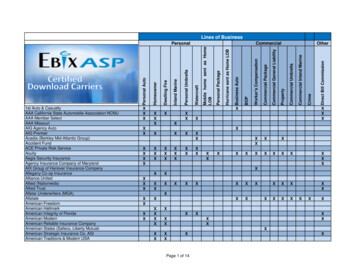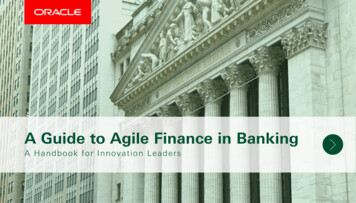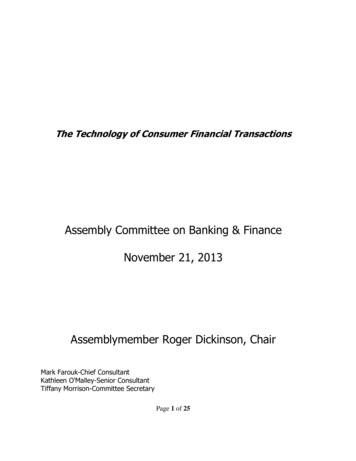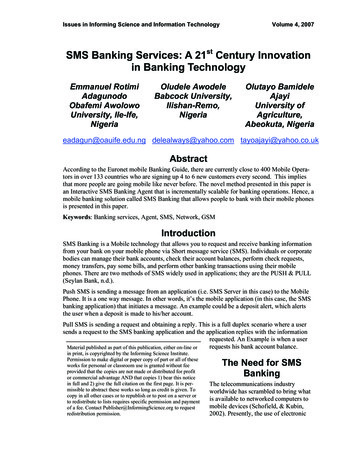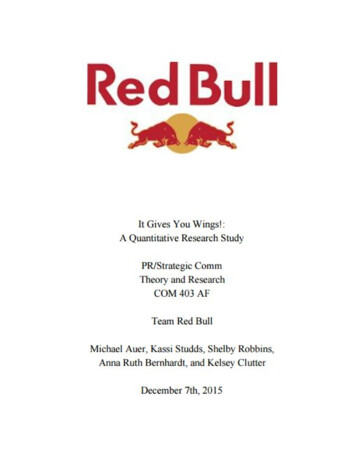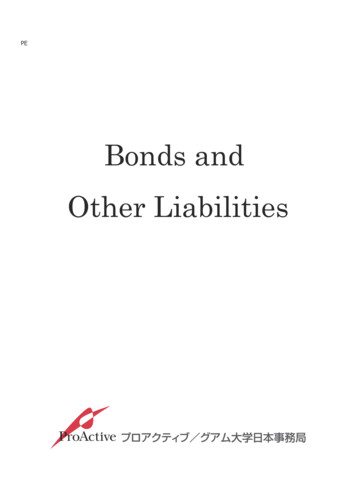
Transcription
22Banking, Other Commercial Financeand InsuranceIntroductionThe International Monetary Fund (IMF) described the Philippine banking systemas a well-capitalized and generally with a high asset quality in 2010. Accordingly, theBangko Sentral ng Pilipinas (BSP), in its Philippine Financial System StabilityAssessment Update in January 2010, reported that the Philippine financial systemremained fundamentally sound and stable. The Bank’s capital adequacy ratio stood at15 percent, comfortably above the 10 percent prescribed by the BSP and the 8percent set by international standards. According to the BSP, the strength of thebanking system was boosted by its sustained efforts to enhance the delivery offinancial services in the economy by opening further doors to financial innovation, andby promoting market discipline and more competition.The BSP’s continued advocacy in promoting inclusive growth and alleviatingpoverty goes beyond the preservation of monetary and financial stability.Implementation of various initiatives to support the development of sustainablemicrofinance business environment in the country is a product of the BSP’s proactivestance in microfinance. It expanded further the access to mainstream financialproducts and services by the unbanked and underserved population. As reported, thePhilippines moved up to number two position in 2010 from the number three slot in2009 in terms of the overall microfinance business standing.Greater public awareness of economic and financial issues is being promotedby the BSP through its Economic and Financial Learning Program (EFLP) to enablehouseholds and businesses to make well-informed economic and financial decisions.The BSP also extended its campaign effort in promoting a culture of saving amongoverseas Filipinos and enable them to use these savings in productive investments.22.1 The Philippine Financial SystemA vital element in securing sustained economic growth and stability is astrong and progressive financial system. Such a system stimulates the effectivetransformation of savings into investments and serves as a financial intermediarybetween savers and spenders. It likewise facilitates the channeling of loanable fundsfrom surplus spending units to deficit spending units to fuel production and boosteconomic growth.As of 2010, the Philippine financial system is composed of 8,869 banks,4,679 of which were commercial banks, 1,419 thrift banks and 2,771 rural banks. Thebanking industry runs 35.7 percent of the 24,874 total number of financial institutions.
Banking, Other Commercial Finance and InsuranceNonbank institutions were a total of 16,005 that includes investment houses,finance companies, investment companies, securities dealers and brokers,pawnshops, lending investors, non-stock savings and loan associations, mutualbuilding and loan associations, venture capital corporations, and others like privateand government insurance companies (SSS and GSIS). Nonbank institutionscomprised 64.3 percent of the number of financial institutions operating in the country.(See Table 22.1)The banking institution dominates when it comes to resources. They ownedPhP7.23 trillion or 80 percent of the PhP9.04 trillion total financial resources.Commercial banks have PhP6.42 trillion shares or 88.9 percent of the total bankingresources while thrift and rural banks have 8.7 percent and 2.5 percent, respectively.(See Table 22.2)The Philippine financial resources have grown significantly over the past nineyears averaging an annual growth rate of 9.1 percent. The remarkable 13.4 percentincrease posted in 2010 was second highest to the 20.7 percent recorded in 2006. Itcan be recalled that in 2001, the financial system had experienced global slowdownregistering only 2.0 percent growth rate. It showed abrupt recovery however, in 2002with 6.1 percent growth rate. From its highest peak in 2006, its growth slid down tonegative 0.6 percent in 2007 as perceived due to the political turmoil. However, itdramatically bounced back to 10.0 percent growth in 2008. These growths wereattributed to the increase in deposit mobilization and build-up of the capital base of thebanking system. (See Table 22.2)Resources of the Philippine financial system refer to the total assets ofcommercial banks, thrift banks, specialized government banks, rural banks andnonbanks financial intermediaries, net of interbank transactions but gross of provisionfor probable losses, accumulated market gains and losses.22.2 Philippine Banking InstitutionsThe history of the Philippine banking system spans nearly five centuries. Itshistory and evolution can be generally divided into epochs: the Spanish Period (15941900), American Period (1900-1941), Japanese Period (1942-1945), Postwar Period(1946-1948), and the Central Bank Era (1949 to present).To make the monetary and banking system responsive to the rehabilitationand development of the economy, the Central Bank of the Philippines (CBP), now theBangko Sentral ng Pilipinas (BSP) was established in 1949. At that time, there wereonly 11 head offices and 75 branches of commercial banks in operation. Faith in thebanking system perked up in the 1950s. Suddenly, seven commercial banks wereorganized and 44 branches were established, making a total of 137 commercialbanking offices operating at the end of 1959. Even more rapid expansion took placethe decade after, with 24 commercial banks and 483 branches added to the system.The same was true with savings, development and rural banks, and savings and loanassociations.Under Republic Act (RA) 337 or the General Banking Act, as amended byPresidential Decree (PD) 71, banking institutions are classified into three generalcategories: commercial banks, thrift banks (composed of savings and mortgagebanks, private development banks, and stock savings and loan associations), and
NSO 2010 Philippine Yearbookregional unit banks composed of rural banks. Specialized government banks, such asthe Development Bank of the Philippines (DBP) and Land Bank of the Philippines(LBP), are not covered by this classification but are subject to the supervision of theCBP, which is the nucleus of the country’s banking system.In the early 1970s, nonbank financial institutions, such as investment housesand finance companies, began their operations. European currency banking started inthe Philippines when the CBP launched a program to establish foreign currencydeposit units (FCDUs) of local commercial banks and accept foreign currency holdingsof Filipinos abroad. The FCDUs became the forerunner of offshore banking units(OBUs) appearing by mid-1977.As the 1980s ushered in a new era, financial reforms were adopted. Amongthem were the introduction of expanded commercial banking, reduction indifferentiation among categories of banks and nonbank financial intermediariesauthorized to perform quasi-banking, elimination of all functional distinctions amongthrift banks, and increase in the powers and functions of nonbank financialintermediaries authorized to perform quasi-banking functions.In the early 1990s, significant change included the loosening up of bankbranching policies, reduction of reserve requirements on bank deposit substituteliabilities, and liberalization of rules on domestic commercial banks’ net foreignexchange positions. These reforms enhanced efficiency and competition amongfinancial intermediaries and attracted numerous investments.Banking reforms are still being pursued to keep the system finely tuned andcompetitive given the demands of the new millennium. The BSP advocates a policythat encourages mergers and consolidations heading toward the vision of severalmajor local banks and foreign banks accounting for the major portion of the bankingsystem. A package of short-term incentives is being offered by the BSP toconsolidating banks. As of mid-2000, there were nine mergers and consolidationsinvolving 16 commercial banks, a thrift bank, and two rural banks.Another recent reform is the passing of the General Banking Law 2000,which supersedes the half-century old General Banking Act of 1949. This basic legalfabric governing the banking system, in essence, works to improve transparency byputting in place internationally accepted standards relating to risk-based capitaladequacy, and enhancing competition by allowing foreign banks to acquire up to 100percent of the voting stock of an existing bank within seven years from the effectivity ofthe law.Other continuing reforms are the amendments to the New Central Bank Actbeing pushed by the BSP and the development of a system and guidelines forimproved regulatory oversight and bank compliance. Broadly speaking, theselegislative measures aim to enhance the supervisory and enforcement powers of theBSP while further improving prudential standards for the banking system, intensifyingcompetition in the banking sector, and enhancing the BSP’s independence.The Central Bank of the Philippines: Then and NowUnder its original charter, the CBP--now known as Bangko Sentral ngPilipinas (BSP)--was called upon to maintain monetary stability by promoting a low andstable inflation conducive to a balanced and sustainable economic growth; ensure thepreservation of the international value and convertibility of the peso into other freely
Banking, Other Commercial Finance and Insuranceconvertible currencies; and, promote an increasing level of production, employment,and real income.PD 72, upon the recommendation of the Joint International Monetary Fund(IMF)-CBP Banking Survey Commission, amended the charter by redirecting theCBP’s primary objectives. Maintaining the internal and external stability of the peso,and fostering monetary, credit, and exchange conditions conducive to a balanced andsustainable growth of the economy became the thrusts of CBP.Besides credit control, monopoly of currency issue and custody, andmanagement of foreign exchange reserves, the CBP now regulates and supervisesthe banking system and exercises regulatory power over the operations of nonbankfinancial institutions. The CBP simplifies banking classification by performing clearingfunctions and exercising custody of commercial banks’ reserves. It also has the powerto take preventive action against insufficiently funded financial institutions and mayimpose a legal structure for banks, minimum paid-up capital requirements, andguidelines for management qualifications of personnel of the applicant institution. Itprovides monetary and credit regulations to control the solvency and liquidity of banks,restricts the types of business that they may engage in, and limits the exposure thatbanks may take according to perceived risks relative to such exposures.Further, the CBP has the authority to revoke licenses and take necessaryaction to straighten out banks’ affairs, which may include any combination of actions,such as rehabilitation, merger, or closure. To the government, it acts as a fiscal agentand financial adviser. In addition, the CBP has been authorized to collect, through thebanking system, national revenue taxes, customs duties, and other levies, includingstabilization taxes.The strategy of the CBP in pursuing its objectives took the forms of exchangeand trade controls in the 1950s; monetary and credit regulation in a free economy withan adjusted but fixed exchange rate in the 1960s; and monetary and creditmanagement, external debt management, and regulation of certain exchangetransactions under a “floating currency” in the 1970s.In 1972, the CBP initiated measures to encourage economies-of-scale inbanking and improve its supervision over the financial sector. It organized foreignsavings through the introduction of a foreign currency system for domestic banks in1972 and an offshore banking system for foreign banks in 1976. In 1980, a new set ofmultipurpose institutions called unibanks, in which the resources of commercial banksare coupled with those of investment house or merchant was developed with greatercapacity to generate long-term investment capital.When the foreign exchange and financial crises erupted in 1983, the CBPclosed down several institutions, and bailed out others. In effect, it reformed thebanking sector, expanded the capital base of banks, and exercised stricter controlover all aspects of the financial system. It raised the reserve requirement from 18.0percent in 1982 to 24.0 percent in 1984, and introduced Central Bank bills, whichyielded high interest.In 1993, RA 7653 reorganized the CBP into the current BSP, arming thelatter with greater flexibility in the execution of monetary policies. The Monetary Boardapproved on January 18, 1994 the new organizational structure of the BSP.The BSP was established as an independent central monetary authoritypursuant to the constitution and the New Central Bank Act of 1993 as part of therestructuring of the old Central Bank of the Philippines, which was originally
NSO 2010 Philippine Yearbookestablished in 1949. Substantial deficits in CBP’s operations led to its restructuringinto the BSP. Under the New Central Bank Act, the BSP was granted increased fiscaland administrative autonomy from other government sectors. As such, the BSP nolonger undertakes certain quasi-fiscal activities and is not permitted to engage indevelopment banking or financing.On July 3, 1998, BSP’s supervision and regulation of non-banking entitieswere turned over to the Securities and Exchange Commission (SEC) for corporationsand partnerships and to the Department of Trade and Industry (DTI) for singleproprietorships in accordance with Section 30 of R.A. No. 7653. However, the nonbanks with quasibanking functions and/or with trust or Investment ManagementActivities (IMA) license, nonbanks which are subsidiaries/affiliates or banks and quasibanks, non-stock savings and loan associations, pawnshops and venture capitalcorporations were retained under the BSP’s supervision.In the year 2003, the BSP continued instituting several policy measures
thrift banks, and increase in the powers and functions of nonbank financial intermediaries authorized to perform quasi-banking functions. In the early 1990s, significant change included the loosening up of bank-branching policies, reduction of reserve requirements on bank deposit substitute liabilities, and liberalization of rules on domestic commercial banks’ net foreign exchange positions .

